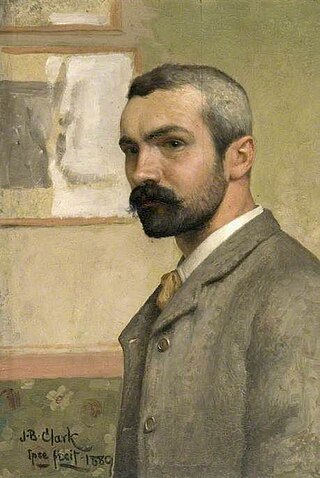
The Peabody Essex Museum (PEM) in Salem, Massachusetts, US, is a successor to the East India Marine Society, established in 1799. It combines the collections of the former Peabody Museum of Salem and the Essex Institute. PEM is one of the oldest continuously operating museums in the United States and holds one of the major collections of Asian art in the United States. Its total holdings include about 1.3 million pieces, as well as twenty-two historic buildings.

Sir Charles Holroyd RE was an English painter, original printmaker and curator during the late Victorian and Edwardian eras up to and including the First World War. He was Keeper of the Tate from 1897 to 1906, Director of the National Gallery from 1906 to 1916 and Assessor (Vice-President) of the Royal Society of Painter-Etchers & Engravers from 1902 to 1917.

Frank Weston Benson, frequently referred to as Frank W. Benson, was an American artist from Salem, Massachusetts known for his Realistic portraits, American Impressionist paintings, watercolors and etchings. He began his career painting portraits of distinguished families and murals for the Library of Congress. Some of his best known paintings depict his daughters outdoors at Benson's summer home, Wooster Farm, on the island of North Haven, Maine. He also produced numerous oil, wash and watercolor paintings and etchings of wildfowl and landscapes.

Reinier Nooms, also known as Zeeman or Seeman, was a Dutch maritime painter known for his highly detailed paintings and etchings of ships. From the 1650s, Nooms started producing and initially publishing a series of etchings of ships and topographical views. This etching work is characterised by great refinement and was used by many other artists as an example.

Robert Salmon was a maritime artist, active in both England and America. Salmon completed nearly 1,000 paintings, all save one of maritime scenes or seascapes. He is widely considered the Father of American Luminism.

Antonio Nicolo Gasparo Jacobsen was a Danish-born American maritime artist known as the "Audubon of Steam Vessels".
Jacques Reich was a Hungarian portrait etcher, active mainly in the United States.

Ange-Joseph Antoine Roux, "Antoine Roux" (1765–1835) was a French fine art painter who specialised in maritime painting, sometimes referred to as marine art.

William Brassey Hole was a Scottish Victorian painter, illustrator, etcher, and engraver, known for his industrial, historical and biblical scenes.
William Henry Mote (1803–1871) was a British stipple and line engraver, primarily known for his portraits. He produced etchings for reference books, as well as original etchings. Mote became a member of the Royal Academy in his twenties and his portraits hang in the National Portrait Gallery, London.

Michele Felice Cornè (1752–1845) was an artist born in Elba who settled in the United States. He lived in Salem and Boston, Massachusetts; and in Newport, Rhode Island. He painted marine scenes, portraits, and interior decorations such as fireboards and murals.
Yngve Edward Soderberg was an American artist whose career was centered on Mystic, Connecticut. He is credited with being a painter, etcher, writer, teacher, designer, and lithographer. He is best known for his etchings, America's Cup paintings and maritime watercolors.

George Ropes Jr. (1788–1819) was an American artist, known for his maritime oil paintings.

Joseph Benwell Clark was an English painter, etcher, engraver in mezzotint and drypoint, and book illustrator.

Charles Albert Waltner, aka C. A. Waltner was a French artist and etcher. His father, Charles Jules Waltner, was also a French artist and etcher who engraved religious subjects for specialized publishers from 1848. Waltner studied painting under the guidance of Jean-Léon Gérôme and Léon Bonnat. Later he was taught by Henriquel-Dupont in the art of copper cutting and etching.

Edith Loring Getchell was an American landscape painter and etcher, highly regarded for the "exquisite" tonalism of her etchings, drypoints and watercolors." Working during the "American Etching Revival," a period that lent legitimacy to an art form that had once been scorned as commercial, Getchell made use of the opportunities the vogue for etching gave her, despite a crowded field and the gender discrimination of her era. Considered one of America's leading etchers in her lifetime, Getchell's work is notable for its skill, its aesthetic values and its approach to depicting American landscape.













